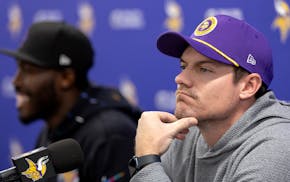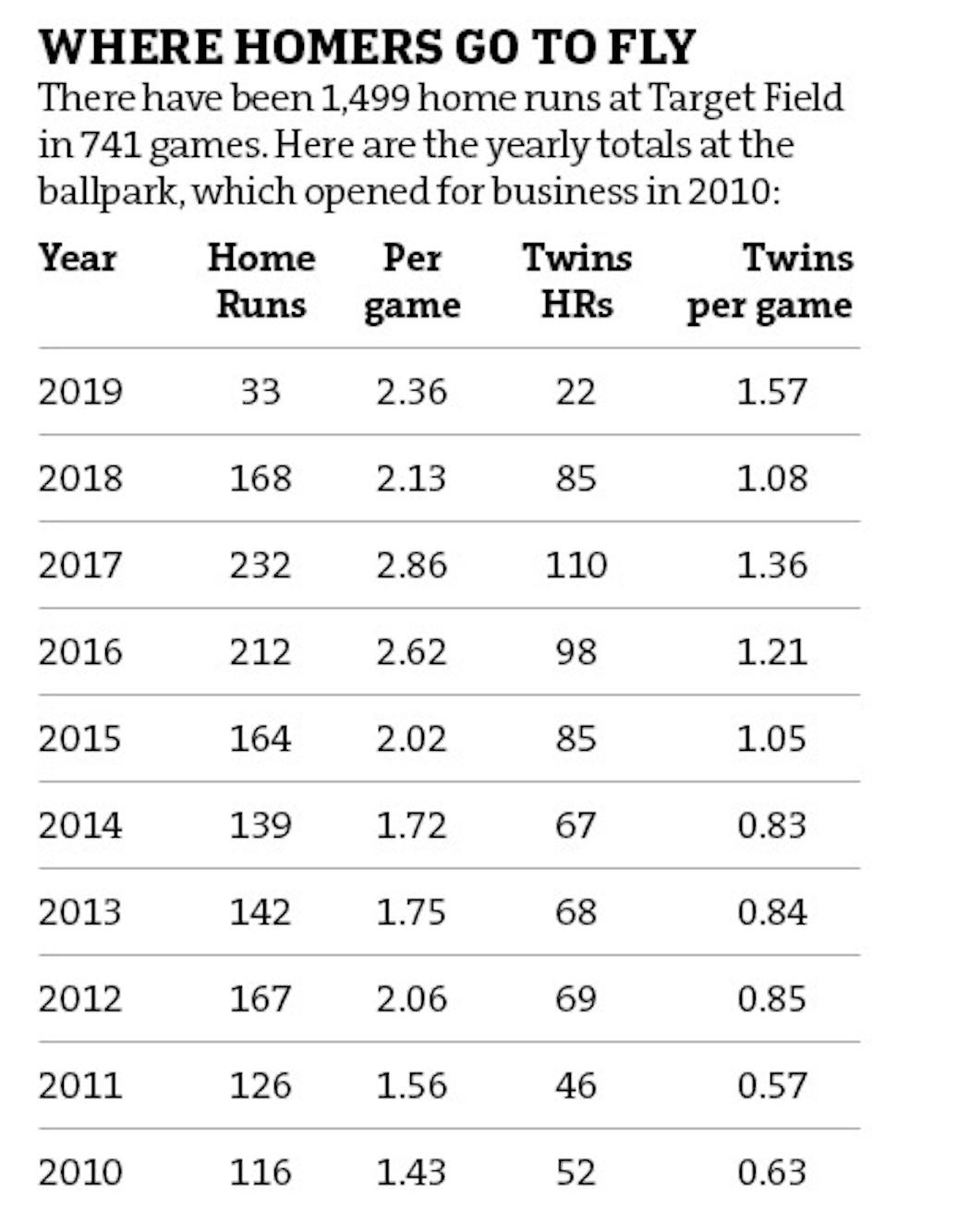Eddie Rosario, the current American League leader in home runs, pointed toward left field, where he spends most of his time at Target Field. "Where I hit [the opposite way], the wall is small," as opposed to the looming 23-foot barrier in right, Rosario said. "I love that. I love this park."
As Target Field nears its decade-old milestone, and a home-run milestone as well, he's not the only one. There have been 1,499 home runs hit during Target Field's 741 regular-season games, and sometime Wednesday night, more than likely, the 1,500th home run in the ballpark's history will sneak over that wall, or sail over the limestone in right field, or rain down on the bullpens.
Rosario wouldn't mind if it's his. "It's a good place to hit," he said. "You see the ball good, and if you hit it good, it goes."
It goes a lot more frequently these days. Like Rosario, the downtown ballpark has experienced a big spike in home runs this season, though that simply mirrors the trend around the game and reflects the Twins' offseason acquisition of power hitters.
"It's the game that's changing, not the ballpark," said Kyle Gibson, who, by dint of starting more games and pitching more innings than anyone else at Target Field, has also allowed the most home runs there: 50. "For the most part, I've always thought of this park as fair. The wind can make things tough sometimes, but otherwise, it's a good place to pitch."
Good to pitch, good to hit: That's the balance the team was looking for when it designed the place, but it wasn't always certain that that's what they would get. For one thing, the 8-acre plot of land it sits on, one of the smallest in baseball, always made the architecture tricky.
"We were worried that the site was so compact, that we would create a bandbox," said Matt Hoy, Twins senior vice president for operations.
Populous, the firm hired to design Target Field, "did a lot of wind studies and weather studies to make sure the site didn't have some [natural factor] we didn't know about," he said, as happened so often at Candlestick Park in San Francisco, for example.
Then the park opened, and home runs became scarce. The Twins didn't hit their 100th there until the beginning of Target Field's third season, and hitters began complaining, at least internally: The right field wall is too high. The power alleys are too deep. The wind is knocking down too many deep fly balls.
Twins executives quietly began discussing options for helping the hitters, team President Dave St. Peter later confirmed, probably by moving fences in where possible. But General Manager Terry Ryan argued against it, and the dimensions were never touched.
"We're probably fortunate that nothing was ever formally drawn up," Hoy said, "because we started hitting homers."
So did everybody, of course. Home runs around the major leagues have surged to record levels over the past decade, rising 21% leaguewide since Target Field opened. And this season's Twins are on pace to hit 311 home runs and shatter their franchise record of 225, set more than a half-century ago. They've smashed 22 homers at Target Field already, a pace that would give them 137 for the season, or as many as they collected in their first 2½ seasons there.
"It's an exciting group. We knew coming into the year that we had a chance to hit some balls over the fence," Twins manager Rocco Baldelli said. "As far as the specifics of the park, I haven't seen anything drastic. I would expect as it warms up, probably the ball will carry a little better."
He's right about that: History shows that home run rates rise from 1.76 per game during April's chill to 2.24 in June's humidity, or an extra home run for every two games.
But through the fluctuations, the Twins' home park has remained close to average for power hitters. It's had the 19th-most homers in the game, despite also being the home of the team with the highest collective ERA in that time. Last year, it had the 20th-most.
"We wanted the park to be in the middle of the pack for offensive performance, and that's been pretty consistent," Hoy said. "You don't want to be known as a pitcher's park where it's impossible to score, and you don't want to be too easy for the hitters."
The open plaza in right field occasionally creates a sort of wind-tunnel effect toward left, which pitchers are acutely aware of, he said. "The first thing I do on the mound is look at the U.S. flag," Gibson said. "If it's flapping toward left field, you have to be especially careful about keeping the ball in the park."
But the reverse is true, too, said Jose Berrios. After giving up a long fly ball on Saturday to Baltimore's Chris Davis, a ball that Byron Buxton was able to get to before it hit the ground, "I say to myself, 'OK, today we are safe. We can throw fastballs and they don't have a good chance to hit homers,' " Berrios said.
Of course, the Twins hit five that day. "I guess we're just hitting the ball really well," Berrios said with a laugh.
Would he rather pitch in a more pitcher-friendly park? "I don't think so. I like it," Berrios said. "I say thank you to the guy who built this park with the right field wall so high. That's my favorite part."
Minnesota's Naz Reid wins NBA's Sixth Man of the Year award, edging Malik Monk in close vote



